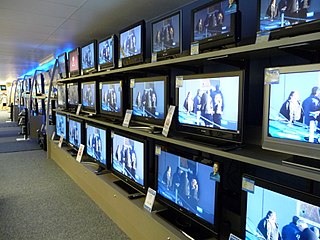This article needs to be updated.(November 2014) |
For most of the population, radio and television are the most important sources of information. [1] During the civil war (1992–97), the Rakhmonov government severely repressed both broadcast and print media; since that time, neither has recovered independent operations. [1] In 2006 six government television stations and 18 private stations were in operation, but most of the latter depended on government transmission equipment. [1] Although the law requires registration of independent broadcast outlets, some unlicensed stations have operated. [1] Russian channels are received by satellite, and most regions receive one of the two national television channels. [1] Radio stations broadcast in Persian, Russian, Tajik, and Uzbek. [1] In 2000 there were 141 radios and 326 television sets per 1,000 population. [1]

Radio is the technology of signalling or communicating using radio waves. Radio waves are electromagnetic waves of frequency between 30 hertz (Hz) and 300 gigahertz (GHz). They are generated by an electronic device called a transmitter connected to an antenna which radiates the waves, and received by a radio receiver connected to another antenna. Radio is very widely used in modern technology, in radio communication, radar, radio navigation, remote control, remote sensing and other applications. In radio communication, used in radio and television broadcasting, cell phones, two-way radios, wireless networking and satellite communication among numerous other uses, radio waves are used to carry information across space from a transmitter to a receiver, by modulating the radio signal in the transmitter. In radar, used to locate and track objects like aircraft, ships, spacecraft and missiles, a beam of radio waves emitted by a radar transmitter reflects off the target object, and the reflected waves reveal the object's location. In radio navigation systems such as GPS and VOR, a mobile receiver receives radio signals from navigational radio beacons whose position is known, and by precisely measuring the arrival time of the radio waves the receiver can calculate its position on Earth. In wireless remote control devices like drones, garage door openers, and keyless entry systems, radio signals transmitted from a controller device control the actions of a remote device.

Television (TV), sometimes shortened to tele or telly, is a telecommunication medium used for transmitting moving images in monochrome, or in color, and in two or three dimensions and sound. The term can refer to a television set, a television program, or the medium of television transmission. Television is a mass medium for advertising, entertainment and news.

Russia, officially the Russian Federation, is a transcontinental country in Eastern Europe and North Asia. At 17,125,200 square kilometres (6,612,100 sq mi), Russia is by a considerable margin the largest country in the world by area, covering more than one-eighth of the Earth's inhabited land area, and the ninth most populous, with about 146.77 million people as of 2019, including Crimea. About 77% of the population live in the western, European part of the country. Russia's capital, Moscow, is one of the largest cities in the world and the second largest city in Europe; other major cities include Saint Petersburg, Novosibirsk, Yekaterinburg and Nizhny Novgorod. Extending across the entirety of Northern Asia and much of Eastern Europe, Russia spans eleven time zones and incorporates a wide range of environments and landforms. From northwest to southeast, Russia shares land borders with Norway, Finland, Estonia, Latvia, Lithuania and Poland, Belarus, Ukraine, Georgia, Azerbaijan, Kazakhstan, China, Mongolia and North Korea. It shares maritime borders with Japan by the Sea of Okhotsk and the U.S. state of Alaska across the Bering Strait. However, Russia recognises two more countries that border it, Abkhazia and South Ossetia, both of which are internationally recognized as parts of Georgia.
In the post-Soviet era, newspaper circulation has decreased sharply because of the high expense of materials and the poverty of the population. [1] As a result of government pressure and refusal of license renewals, no opposition newspapers were operating in the run-up to the 2006 presidential election. [1] Among the most-read newspapers are Jumhuriyat (Republic, in Tajik, thrice weekly), Khalk ovozi (Voice of the People, in Uzbek, thrice weekly), Kurer Tadzhikistana (Tajikistan Courier, in Russian, weekly), Sadoi mardum (Voice of the People, in Tajik, thrice weekly), and Tojikiston (Tajikistan, in Tajik, thrice weekly). [1] In 2006 four domestic news agencies and one Russian agency (RIA Novosti) were operating. [1]

A newspaper is a periodical publication containing written information about current events and is often typed in black ink with a white or gray background.
Jumhuriyat is a thrice weekly newspaper published in Tajikistan. It is one of the most widely circulated papers in the country.
Khalk ovozi is a thrice weekly newspaper published in Dusanbe, Tajikistan.







